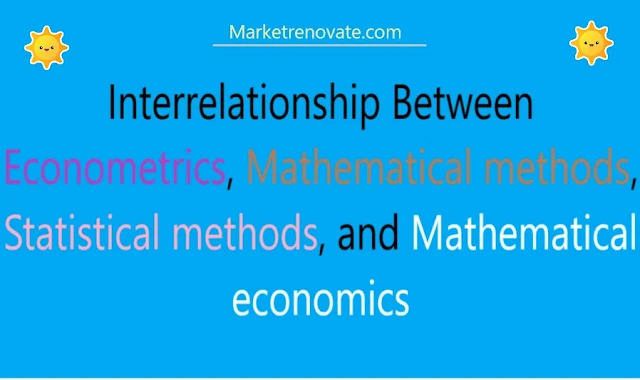Interrelationship Between Econometrics, Mathematical methods, Statistical methods, and Mathematical economics
Econometrics is studying economic data and testing economic theories using mathematical methods, statistical methods, and economic theory. Models that describe the relationships between economic variables are developed using mathematical methods, and these models are estimated and tested using real-world data using statistical methods. The combination of these methods is what makes econometrics such a potent tool for economic analysis.
Another field that is closely related to econometrics is mathematical economics. It employs mathematical methods to create economic models that can be used to analyze economic phenomena and forecast future trends. These models, which frequently include assumptions about human behavior and decision-making, can be used to test economic theories and assess the effectiveness of various policy interventions.
While econometrics and mathematical economics may appear complex and intimidating, their underlying principles are based on everyday economic observations. Economists can gain insights into the complex relationships between economic variables and better understand how the economy works by analyzing economic data using mathematical and statistical methods. This knowledge can then guide policy decisions and promote economic growth and prosperity.
Econometrics, mathematical methods, statistical methods, and mathematical economics are all related fields with many commonalities. However, there are important differences between them as well.
Key features and differences between Econometrics, mathematical methods, statistical methods, and mathematical economics
| Field | Key Features | Differences |
|---|---|---|
| Econometrics | Application of mathematical and statistical methods to economic data for analysis and testing of economic theories | Focused on using economic data to test economic theories and make policy recommendations |
| Mathematical Methods | Application of mathematical concepts and techniques to economic models and theories | Focused on using mathematical tools to develop economic models and theories |
| Statistical Methods | Application of statistical techniques to analyze data and test hypotheses | Focused on using statistical tools to analyze data and test hypotheses |
| Mathematical Economics | Study of economic models and theories using mathematical techniques and concepts | Focused on using mathematical tools to develop and analyze economic models and theories |
Here are some additional points that highlight the differences between these fields:
- Econometrics combines mathematical and statistical methods to analyze economic data, while mathematical and statistical methods focus more on their respective domains.
- Mathematical economics is concerned with developing and analyzing economic models, while econometrics focuses on using models to analyze real-world data.
- Statistical methods are primarily used to analyze data and test hypotheses, while econometrics uses statistical methods to analyze economic data and test economic theories.
- Mathematical methods are used to develop and refine economic models, which can then be tested using econometric and statistical methods.
- Econometrics uses data to make predictions and inform policy decisions, while mathematical economics focuses on understanding the underlying mechanisms that drive economic behavior.
- Mathematical economics is closely related to microeconomic theory, while econometrics is more closely related to empirical macroeconomics.
- Econometrics & its Origin and Definitions
- Nature, Types, and Sources of Econometric Data
- Procedures of Econometric Modelling
- Uses and Applications of Econometrics
- Relationships between Econometrics, Mathematics, and Statistics
- Business Econometrics – Importance and Procedures
- Environmental econometrics – Meaning, Uses, and Procedures
- Estimation and Types of Estimation
- Properties of Estimators – Small Sample and Large Sample
- Ordinary Least Squares (OLS) Derivation






Please leave your comments or ask your queries here. The comments shall be published only after the Admin approval.